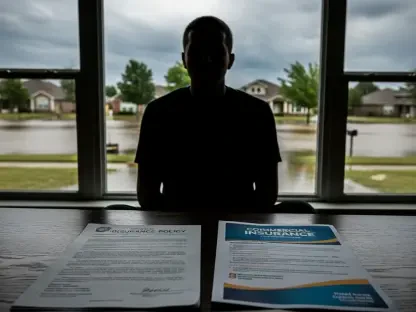Florida homeowners are facing a pivotal moment as Citizens Insurance, the state-backed provider often seen as a last resort, introduces significant rate adjustments for the current year, effective since June 1. For many residents already grappling with some of the highest insurance costs in the nation, these changes could bring either an unexpected financial burden or, for a fortunate few, a slight reprieve. The stakes are particularly high in a state where the threat of hurricanes looms large, shaping a volatile insurance market that leaves countless individuals reliant on Citizens for protection. This article explores the driving forces behind these rate shifts, dissects who stands to pay more or less, and examines the broader challenges of insuring property in a region so prone to natural disasters. By delving into the specifics of the adjustments and their implications, a clearer picture emerges of how Florida’s unique environmental risks continue to impact household budgets and coverage options.
Unpacking Florida’s Insurance Market Struggles
Florida’s homeowners insurance market stands out as one of the most expensive in the United States, a reality rooted in the state’s geographic vulnerability. With an extensive coastline and a narrow landmass, the region is a prime target for hurricanes, wind damage, and flooding, particularly during the intense June-to-November storm season. These environmental risks deter many private insurers from offering coverage, as the likelihood of costly claims remains high. As a result, premiums soar, and availability dwindles, forcing numerous residents to seek refuge with Citizens Insurance. This state-supported entity fills a critical gap, but its role comes with the challenge of managing costs in an inherently risky landscape. Understanding this backdrop is essential to appreciating why rate adjustments are not just routine but a necessary response to sustain coverage in a state where natural disasters are a constant threat.
Beyond the environmental factors, the market’s struggles are compounded by a lack of competition among insurers. Private companies often retreat from Florida due to the financial exposure tied to catastrophic weather events, leaving a void that Citizens must address. This dynamic creates a cycle where high risk translates into high costs for policyholders, many of whom have no alternative but to accept the terms offered by the state-backed provider. The current rate changes, therefore, are not merely about numbers on a bill but reflect deeper systemic issues within the insurance framework. For homeowners, this means navigating a landscape where affordability and accessibility are in constant tension, shaped by forces beyond individual control. The reality of living in such a high-risk zone underscores the importance of staying informed about how these market dynamics influence personal finances.
Breaking Down the Latest Rate Adjustments
Since June 1, Citizens Insurance has rolled out rate changes that vary significantly depending on location and property type, creating a mixed bag of outcomes for policyholders across Florida. For primary residences, the increase is capped at 14%, a notable jump for many budgets, while non-primary properties such as vacation homes face hikes as steep as 50%. Data indicates that roughly 80% of policyholders are seeing an average increase of more than 8%, a shift that could strain finances for the majority. However, a smaller segment—about 20%—primarily in Miami-Dade and Broward counties, benefits from an average reduction of 5.6%. This disparity highlights how regional risk assessments shape pricing, with some areas deemed less vulnerable reaping the rewards. Homeowners must examine their specific circumstances to gauge the true impact of these adjustments on their annual costs.
Drilling deeper into the specifics, the rate hikes also differ by policy category, adding another layer of complexity to the financial picture. For instance, mobile home wind-only policies are seeing a staggering increase of 26.6%, while multi-peril dwelling policies rise by a more moderate 10.4%. These variations underscore that not all properties or coverage types are treated equally under the new structure. Policyholders with specialized needs or less common property types may find themselves bearing a heavier burden, while others might escape with minimal change. The uneven distribution of these adjustments means that understanding one’s exact policy details is crucial for anticipating the effect on household expenses. As these changes settle in, they serve as a reminder of the intricate balance between risk, location, and cost in Florida’s insurance ecosystem.
The Role of Citizens Insurance in a Risky Landscape
Citizens Insurance operates as a vital lifeline for countless Floridians, stepping in as the insurer of last resort when private companies shy away from the state’s daunting risk profile. Established to provide coverage where the market fails, this state-backed entity shoulders the responsibility of protecting homeowners in a region where hurricanes and flooding are ever-present dangers. However, maintaining this safety net requires financial adjustments, as seen in the current rate shifts, to ensure the organization can cover potential claims without collapsing under the weight of widespread disasters. This dual role as both protector and financial manager places Citizens in a challenging position, where affordability for residents must be weighed against operational sustainability in a high-stakes environment.
The significance of Citizens extends beyond simply offering policies; it also plays a part in trying to stabilize Florida’s turbulent insurance market. By absorbing clients that private insurers reject, it prevents a complete collapse of coverage availability, though this often comes at the cost of higher premiums for many. The recent rate changes reflect an attempt to balance these competing priorities, ensuring funds are available for future claims while still providing a critical service. For homeowners, this means relying on an entity that, while essential, must periodically recalibrate its pricing to match the realities of Florida’s risk landscape. The presence of Citizens offers a buffer against an otherwise inaccessible market, but it also ties policyholders to fluctuations driven by broader systemic challenges rather than individual circumstances.
Navigating Insurance During Hurricane Season
Securing insurance coverage in Florida becomes a near-impossible task when a storm is on the horizon, amplifying the importance of year-round preparedness. Most providers, including Citizens Insurance, enforce strict moratoriums on new policies, typically halting applications 24 to 48 hours before an anticipated hurricane. This policy leaves homeowners vulnerable at the most critical moments, unable to protect their property when the risk of damage peaks during the storm season. For those without existing coverage, this restriction can result in devastating financial losses if disaster strikes. The current rate adjustments add another dimension to this challenge, as they may influence decisions about maintaining or adjusting policies well before the threat of a storm emerges.
The limitations during hurricane season underscore a broader issue of timing and access in Florida’s insurance framework. Homeowners must anticipate their needs far in advance, as waiting until a weather event looms is simply not an option. This reality places additional pressure on residents to stay insured with Citizens or other providers, despite rising costs from the latest rate changes. The inability to secure last-minute protection also highlights the need for proactive planning, such as reinforcing properties or setting aside emergency funds, to mitigate potential damages. As the storm season approaches each year, the interplay between coverage restrictions and financial adjustments serves as a stark reminder of the unique hurdles faced by those living in a state so exposed to nature’s unpredictability.
Financial Realities of Insuring in a High-Risk Zone
The cost of homeowners insurance in Florida paints a sobering picture, with annual premiums ranging from $2,625 to $5,761, according to data from sources like BankRate and NerdWallet. In some coastal areas, costs can skyrocket to $11,000, far exceeding the national average of $2,110. These figures reflect the immense financial burden tied to living in a state so susceptible to hurricanes and flooding, where insurers must price policies to account for frequent and severe claims. The recent rate adjustments by Citizens Insurance only intensify this strain for most policyholders, though a select few in specific regions might see a modest decrease. For many, these costs represent a significant portion of household budgets, influenced by factors such as location, credit history, and now, the latest pricing shifts.
Examining the broader implications, these high insurance costs shape more than just individual finances; they influence decisions about where to live and how to protect property in Florida. Residents in high-risk zones often face a stark choice between paying exorbitant premiums or risking catastrophic loss without coverage. The disparity in rates following the current adjustments—where some areas benefit from reductions while others see sharp increases—further complicates this landscape. Homeowners must weigh the value of staying insured against other pressing expenses, a dilemma made more acute by the state’s environmental challenges. As these financial realities persist, they highlight the ongoing tension between the need for protection and the affordability of maintaining it in a region defined by its exposure to natural disasters.
Looking Back at the Rate Shift Impact
Reflecting on the rollout of Citizens Insurance rate adjustments that took effect on June 1, the varied impact on Florida homeowners became evident. Many faced steeper bills, with 80% of policyholders absorbing increases averaging over 8%, while a smaller group in counties like Miami-Dade and Broward saw welcome reductions. These changes, shaped by regional risk and property type, revealed the complexity of balancing insurer sustainability with resident affordability in a state battered by natural threats. Moving forward, homeowners might consider reviewing policy details to identify potential savings or exploring property reinforcements to lower risk profiles. Engaging with state resources or local initiatives aimed at stabilizing insurance costs could also provide relief. As Florida continues to navigate its challenging market, staying proactive about coverage options and advocating for broader market reforms may offer a path to mitigate future financial shocks.









